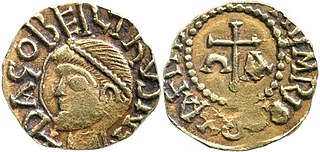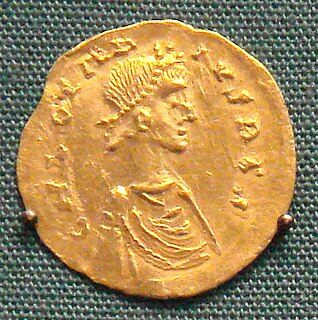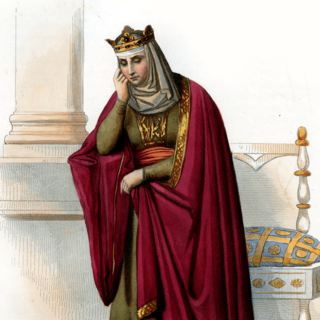
Pepin Iof Landen, also called the Elder or the Old, was the Mayor of the palace of Austrasia under the Merovingian King Dagobert I from 623 to 629. He was also the Mayor for Sigebert III from 639 until his death.

Austrasia was a territory which formed the north-eastern section of the Merovingian Kingdom of the Franks during the 6th to 8th centuries. It was centred on the Meuse, Middle Rhine and the Moselle rivers, and was the original territory of the Franks, including both the so-called Salians and Rhineland Franks, which Clovis I conquered after first taking control of the bordering part of Roman Gaul, now northern France, which is sometimes described in this period as Neustria.

Dagobert I was the king of Austrasia (623–634), king of all the Franks (629–634), and king of Neustria and Burgundy (629–639). He has been described as the last king of the Merovingian dynasty to wield any real royal power. Dagobert was the first of the Frankish kings to be buried in the royal tombs at Saint Denis Basilica.

Chlothar II, called the Great or the Younger , was king of Neustria and king of the Franks, and the son of Chilperic I and his third wife, Fredegund. He started his reign as an infant under the regency of his mother, who was in an uneasy alliance with Chlothar's uncle King Guntram of Burgundy, who died in 592. Chlothar took power upon the death of his mother in 597; though rich, Neustria was one of the smallest portions of Francia. He continued his mother's feud with Queen Brunhilda with equal viciousness and bloodshed, finally achieving her execution in an especially brutal manner in 613, after winning the battle that enabled Chlothar to unite Francia under his rule. Like his father, he built up his territories by seizing lands after the deaths of other kings.

The Carolingian dynasty was a Frankish noble family named after Charlemagne, grandson of mayor Charles Martel and descendant of the Arnulfing and Pippinid clans of the 7th century AD. The dynasty consolidated its power in the 8th century, eventually making the offices of mayor of the palace and dux et princeps Francorum hereditary, and becoming the de facto rulers of the Franks as the real powers behind the Merovingian throne. In 751 the Merovingian dynasty which had ruled the Germanic Franks was overthrown with the consent of the Papacy and the aristocracy, and Pepin the Short, son of Martel, was crowned King of the Franks. The Carolingian dynasty reached its peak in 800 with the crowning of Charlemagne as the first Emperor of the Romans in the West in over three centuries. His death in 814 began an extended period of fragmentation of the Carolingian Empire and decline that would eventually lead to the evolution of the Kingdom of France and the Holy Roman Empire.
Under the Merovingian dynasty, the mayor of the palace was the manager of the household of the Frankish king.

Francia, also called the Kingdom of the Franks, Frankish Kingdom, Frankland or Frankish Empire, was the largest post-Roman barbarian kingdom in Western Europe. It was ruled by the Franks during Late Antiquity and the Early Middle Ages. After the Treaty of Verdun in 843, West Francia became the predecessor of France, and East Francia became that of Germany. Francia was among the last surviving Germanic kingdoms from the Migration Period era before its partition in 843.

Dagobert II was the Merovingian king of the Franks ruling in Austrasia from 675 or 676 until his death. He is one of the more obscure Merovingians. He has been considered a martyr since at least the ninth century.

Sigebert III was the Merovingian king of Austrasia from 633 to his death around 656. He was described as the first Merovingian roi fainéant —do-nothing king—, in effect the mayor of the palace ruling the kingdom throughout his reign. However he lived a pious Christian life and was later sanctified, being remembered as Saint Sigebert of Austrasia in the Roman Catholic Church and Eastern Orthodox Church.

Brunhilda was queen consort of Austrasia, part of Francia, by marriage to the Merovingian king Sigebert I of Austrasia, and regent for her son, grandson and great-grandson.

Charibert II, a son of Clotaire II and his junior wife Sichilde, was briefly King of Aquitaine from 629 to his death, with his capital at Toulouse. There are no direct statements about when Charibert was born exactly, the only known fact being that he was "a few years younger" than his half-brother Dagobert. His father Clotaire evidently had a bigamous marriage and he was the offspring of the junior wife.
Saint Chlodulf was bishop of Metz approximately from 657 to 697.

The Edict of Paris was promulgated 18 October 614 in Paris by Chlothar II, the Merovingian king of the Franks. It is one of the most important royal instruments of the Merovingian period in Frankish history and a hallmark in the history of the development of the Frankish monarchy. It is the last of the Merovingian capitularia, a series of legal ordinances governing church and realm.
Bodegisel was a Frankish duke (dux). He was the son of Mummolin, duke of Soissons, and served the kings Chilperic I and Childebert II.

Cunibert, Cunipert, or Kunibert was the ninth bishop of Cologne, from 627 to his death. Contemporary sources mention him between 627 and 643.
Radulf was the Duke of Thuringia from 632 or 633 until his death after 642.
According to the pseudohistorical Dossiers Secrets d'Henri Lobineau and related documents, Sigebert IV was the son of the Merovingian king Dagobert II who, on the assassination of his father, was rescued by his sister and smuggled to the domain of his mother the Visigoth princess, Giselle de Razès in Rennes-le-Château. He is said to have arrived in the Languedoc in 681 and, at some point, adopted or inherited his uncle's titles, duke of Razès and count of Rhedae. He is also said to have adopted the surname, or nickname, of “Plant-Ard” from the French appellation ‘rejeton ardent’ ‘ardently flowering shoot’ of the Merovingian vine. Under this name, and under the titles acquired from his uncle, he is said to have perpetuated his lineage.
The Duchy of Thuringia was an eastern frontier march of the Merovingian kingdom of Austrasia, established about 631 by King Dagobert I after his troops had been defeated by the forces of the Slavic confederation of Samo at the Battle of Wogastisburg. It was recreated in the Carolingian Empire and its dukes were appointed by the king until it was absorbed by the Saxon dukes in 908. From about 1111/12 the territory was ruled by the Landgraves of Thuringia as Princes of the Holy Roman Empire.
The royal household of the early kings of the Franks is the subject of considerable discussion and remains controversial. This discussion is aimed at identifying the major categories of participants in the administration and those who made the major historical impacts. Every king of the Franks from Clovis I to Charles the Bald had a large cadre of advisors and bureaucrats that helped implement their regime. These supporters of the crown are frequently unknown, but often are ancestors of the later rulers of France. This is not intended to be a complete list of those supporting the kings but to serve as a guide for further study. A general discussion of the Merovingian and Carolingian dynasties can be found in the associated main articles. See also Government of the Carolingian Empire.